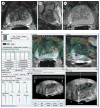Imaging techniques for prostate cancer: implications for focal therapy
- PMID: 19352394
- PMCID: PMC3520096
- DOI: 10.1038/nrurol.2009.27
Imaging techniques for prostate cancer: implications for focal therapy
Abstract
The multifocal nature of prostate cancer has necessitated whole-gland therapy in the past; however, since the widespread use of PSA screening, patients frequently present with less-advanced disease. Many men with localized disease wish to avoid the adverse effects of whole-gland therapy; therefore, focal therapy for prostate cancer is being considered as a treatment option. For focal treatment to be viable, accurate imaging is required for diagnosis, staging, and monitoring of treatment. Developments in MRI and PET have brought more attention to prostate imaging and the possibility of improving the accuracy of focal therapy. In this Review, we discuss the advantages and disadvantages of conventional methods for imaging the prostate, new developments for targeted imaging, and the possible role of image-guided biopsy and therapy for localized prostate cancer.
Conflict of interest statement
The authors and the Journal Editor A Hay declared no competing interests. The CME questions author CP Vega declared that he has served as an advisor or consultant to Novartis, Inc.
Figures




References
-
- American Cancer Society (online 2008) Cancer Facts & Figures 2008. 2009 http://www.cancer.org/downloads/STT/2008CAFFfinalsecured.pdf.
-
- Hricak H, Choyke PL, Eberhardt SC, Leibel SA, Scardino PT. Imaging prostate cancer: a multidisciplinary perspective. Radiology. 2007;243:2028–2053. - PubMed
-
- Cornud F, et al. Endorectal color Doppler sonography and endorectal MR imaging features of nonpalpable prostate cancer: correlation with radical prostatectomy findings. AJR Am J Roentgenol. 2000;175:1161–1168. - PubMed
-
- Yang JC, et al. Contrast-enhanced gray-scale transrectal ultrasound-guided prostate biopsy in men with elevated serum prostate-specific antigen levels. Acad Radiol. 2008;15:1291–1297. - PubMed
-
- Tang J, Yang JC, Li Y, Li J, Shi H. Peripheral zone hypoechoic lesions of the prostate: evaluation with contrast-enhanced gray scale transrectal ultrasonography. J Ultrasound Med. 2007;26:1671–1679. - PubMed
Publication types
MeSH terms
Grants and funding
LinkOut - more resources
Full Text Sources
Other Literature Sources
Medical
Research Materials
Miscellaneous

